A mass for asymptotically complex hyperbolic manifolds
A mass for asymptotically complex hyperbolic manifolds
A mass for asymptotically complex hyperbolic manifolds
Create successful ePaper yourself
Turn your PDF publications into a flip-book with our unique Google optimized e-Paper software.
hal-00429306, version 1 - 2 Nov 2009<br />
12 A MASS FOR ASYMPTOTICALLY COMPLEX HYPERBOLIC MANIFOLDS.<br />
Lemmata 2.4 and 2.5 then yield :<br />
∇Zθ(X,Y )<br />
= i(X,Z)duφ(JY ) − i(Y,Z)duφ(JX) + i(X,JZ)duφ(Y ) − i(Y,JZ)duφ(X)<br />
= −i(X,Z)αφ(Y ) + i(Y,Z)αφ(X) − i(X,JZ)Jαφ(Y ) + i(Y,JZ)Jαφ(X)<br />
and the result follows. <br />
The computations above result in the following proposition (recall(6)).<br />
Corollary 2.7 — If φ is a Kählerian Killing spinor, then Q(φ) := (ξφ,αφ,uφ) is an<br />
element of N0. So we have a map Q : K −→ N0.<br />
When m = 2l − 1 <strong>for</strong> some integer l ≥ 2, the <strong>complex</strong> <strong>hyperbolic</strong> space CH m is<br />
known to carry a space of Kählerian Killing spinors of maximal dimension, C l 2l [Kir].<br />
Where do they come from ? Briefly, constant spinors on C m,1 admit a restriction as<br />
spinors on AdS 2m,1 (cf. Lemma 3 in [Bau]). These are the so-called imaginary Killing<br />
spinors ; they trivialize the spinor bundle of AdS 2m,1 . Among them, thanks to the<br />
parity of m, some are S 1 -invariant (it can be seen on the graduation coming from the<br />
Kähler structure of C m,1 ) and admit a projection into spinors along CH m ([Mor]).<br />
These “projected” spinors are exactly the Kählerian Killing spinors.<br />
To be more explicit, we can adapt the computations of [Kir]. The manifold CH m<br />
carries global coordinates w1,... ,wm, such that π ∗ wk = zk<br />
zm+1 (along AdS2m,1 , where<br />
zm+1 does not vanish). These coordinates induce a trivialization of the canonical<br />
bundle, by √ dw := √ dw1 ∧ · · · ∧ dwm. We will use multi-index a = (a1,... ,ak) with<br />
1 ≤ a1 < · · · < ak ≤ m and set dza := dza1 ∧ · · · ∧ dzak . The computations of [Kir] say<br />
that, if a is a multi-index of length l − 1, the spinor ϕa = ϕa l−1 + ϕa l defined by<br />
ϕ a d ¯wa<br />
l−1 = c(l)<br />
(1 − |w| 2 ) l ⊗ √ dw and ϕ a c(l)<br />
l =<br />
2il ¯ <br />
d ¯wa<br />
∂<br />
(1 − |w| 2 ) l<br />
<br />
⊗ √ dw<br />
is a Kählerian Killing spinor. In this expression, c(l) is a normalization constant, which<br />
we choose to be c(l) = √ 2 5<br />
2 −3l . Another family of Kählerian Killing spinors is described<br />
by spinors ˘ϕ b = ˘ϕ b l−1 + ˘ϕb l where b is a multi-index of length l and<br />
˘ϕ b ι ¯R d ¯wb<br />
l−1 = c(l)<br />
(1 − |w| 2 ) l ⊗ √ dw and ˘ϕ b c(l)<br />
l =<br />
2il ¯ <br />
ι ¯R d ¯wb<br />
∂<br />
(1 − |w| 2 ) l<br />
<br />
⊗ √ dw<br />
where R = <br />
wk∂wk k . These families together <strong>for</strong>m a basis <strong>for</strong> the Kählerian Killing<br />
spinors of CHm . What we are interested in here is their squared norms. Let us<br />
introduce the notation ă <strong>for</strong> the multi-index that is complementary to a (namely, a<br />
and ă have no common index and the sum of their lengths is m), and also the notation<br />
|wa| 2 := |wa1 |2 + · · · + |wak |2 . An adaptation of the computations at the end of [Kir]<br />
yields<br />
<br />
a<br />
ϕ <br />
l−1<br />
2 = |˘ϕ ă l |2 2<br />
1 − |wa|<br />
=<br />
1 − |w| 2 and |ϕ a l |2 = |˘ϕ ă l−1 |2 2<br />
|wă|<br />
=<br />
1 − |w| 2,<br />
hence<br />
|ϕ a | 2 = |˘ϕ ă | 2 = 1 − |wa| 2 + |wă| 2<br />
1 − |w| 2<br />
It follows that π∗uϕa = − |za| 2 + |ză| 2 + |zm+1| 2 (we <strong>for</strong>get the ˘ϕ’s since they do not<br />
yield new squared norms). Now αϕa and ξϕa are determined by uϕa (since these are<br />
.


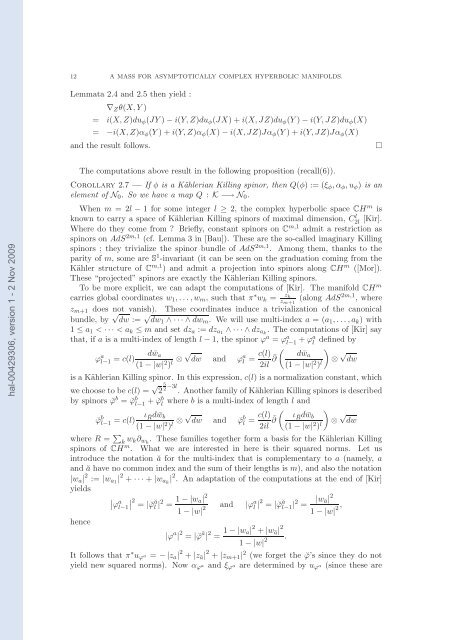

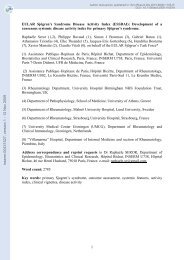
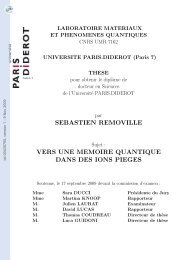
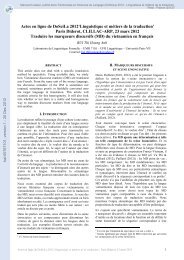
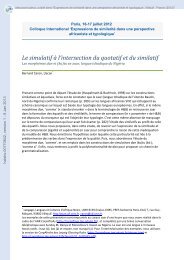
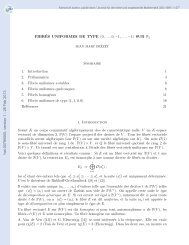
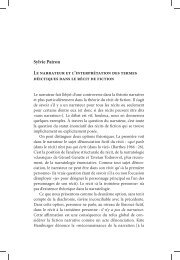
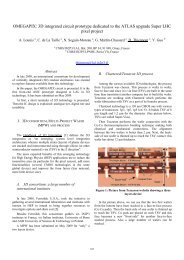
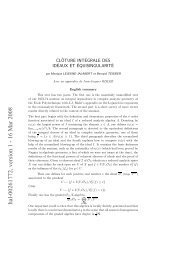
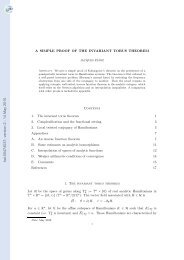



![[tel-00433556, v1] Relation entre Stress Oxydant et Homéostasie ...](https://img.yumpu.com/19233319/1/184x260/tel-00433556-v1-relation-entre-stress-oxydant-et-homeostasie-.jpg?quality=85)